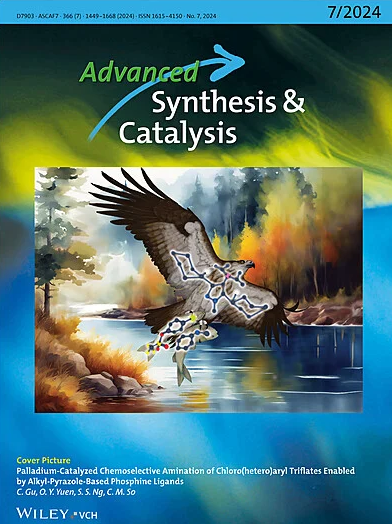在常规和非常规介质中酶催化不对称合成脂肪族邻二醇的所有立体异构体
IF 4.4
2区 化学
Q2 CHEMISTRY, APPLIED
引用次数: 0
摘要
手性邻二醇具有很高的学术研究和工业应用价值。对于手性二醇的合成,酶是重要的催化剂,因为它具有高选择性和在耐受温度和无压力下工作的能力。在这项研究中,连续两个酶催化步骤用于不对称合成脂肪族,邻二醇具有较高的产物浓度和手性纯度。该反应包括使用裂解酶的连接步骤和随后使用氧化还原酶的还原步骤。在含水缓冲液或有机溶剂中,潜在的生物基醛乙醛、丙醛、丁醛和戊醛被用作底物。在这里,2,3-丁二醇、3,4-己二醇、4,5-辛二醇和5,6-癸二醇的所有可能的立体异构体都得到了,异构体含量在72%和>之间;99%,浓度和转化率在4.1和60 mM之间。这项工作展示了如何通过模块化方式结合酶来合成四种对称的,手性的,邻二醇,包括典型的缩放。本文章由计算机程序翻译,如有差异,请以英文原文为准。

Enzymatic Asymmetric Synthesis of All Stereoisomers of Aliphatic, Vicinal Diols in Conventional and Non‐Conventional Media
Chiral, vicinal diols are of high interest for academic research and industrial applications. For synthesizing chiral diols, enzymes are important catalysts due to their high selectivity and ability to work under tolerable temperature and no pressure. In this study, two consecutive enzyme‐catalyzed steps were used for the asymmetric synthesis of aliphatic, vicinal diols with high product concentrations and chiral purity. The reaction comprised a ligation step employing lyases and a subsequent reduction step using oxidoreductases. Either in an aqueous buffer or an organic solvent, the potentially biobased aldehydes acetaldehyde, propanal, butanal, and pentanal were used as substrates. Here, all possible stereoisomers of 2,3‐butanediol, 3,4‐hexanediol, 4,5‐octanediol, and 5,6‐decanediol were produced with isomeric content values between 72% and >99%, and concentrations between 4.1 and 115 mM. This work shows how four symmetric, chiral, vicinal diols can be synthesized by combining enzymes in a modular way, including exemplarily scaling.
求助全文
通过发布文献求助,成功后即可免费获取论文全文。
去求助
来源期刊

Advanced Synthesis & Catalysis
化学-应用化学
CiteScore
9.40
自引率
7.40%
发文量
447
审稿时长
1.8 months
期刊介绍:
Advanced Synthesis & Catalysis (ASC) is the leading primary journal in organic, organometallic, and applied chemistry.
The high impact of ASC can be attributed to the unique focus of the journal, which publishes exciting new results from academic and industrial labs on efficient, practical, and environmentally friendly organic synthesis. While homogeneous, heterogeneous, organic, and enzyme catalysis are key technologies to achieve green synthesis, significant contributions to the same goal by synthesis design, reaction techniques, flow chemistry, and continuous processing, multiphase catalysis, green solvents, catalyst immobilization, and recycling, separation science, and process development are also featured in ASC. The Aims and Scope can be found in the Notice to Authors or on the first page of the table of contents in every issue.
 求助内容:
求助内容: 应助结果提醒方式:
应助结果提醒方式:


